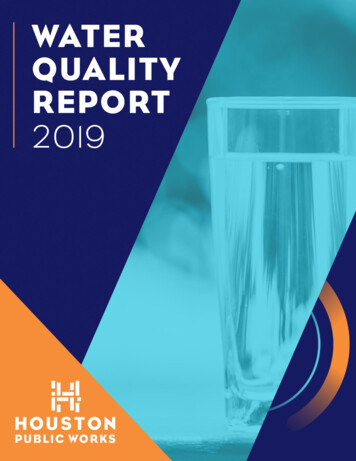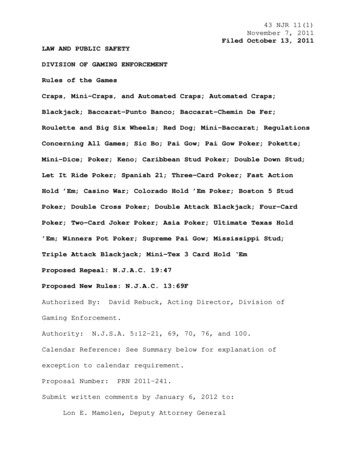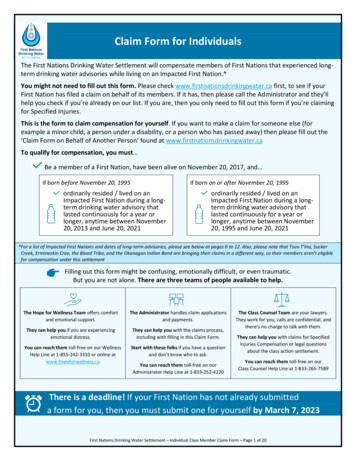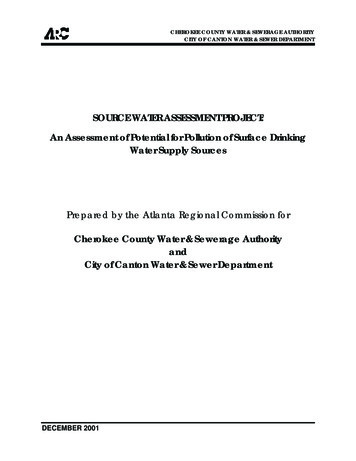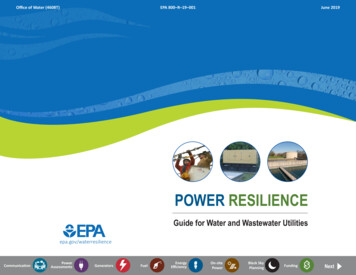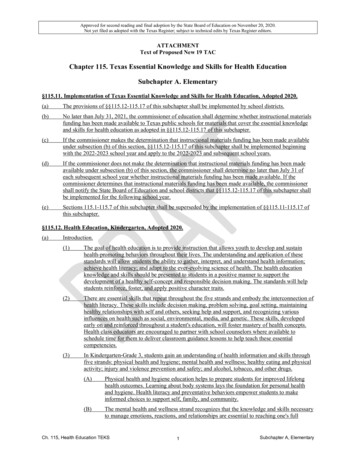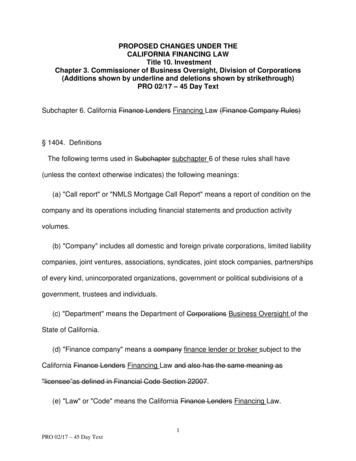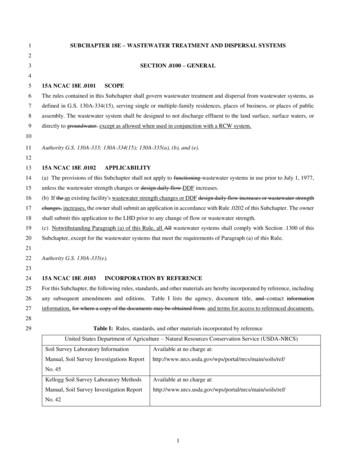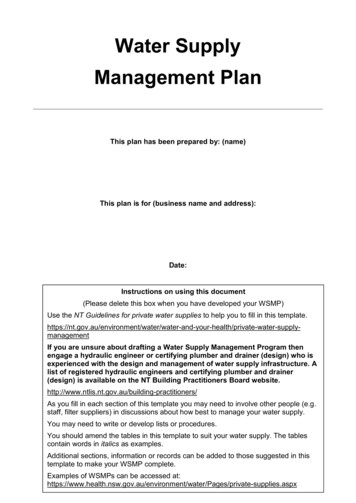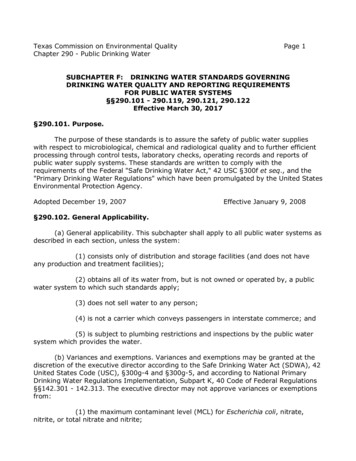
Transcription
Texas Commission on Environmental QualityChapter 290 - Public Drinking WaterPage 1SUBCHAPTER F: DRINKING WATER STANDARDS GOVERNINGDRINKING WATER QUALITY AND REPORTING REQUIREMENTSFOR PUBLIC WATER SYSTEMS§§290.101 - 290.119, 290.121, 290.122Effective March 30, 2017§290.101. Purpose.The purpose of these standards is to assure the safety of public water supplieswith respect to microbiological, chemical and radiological quality and to further efficientprocessing through control tests, laboratory checks, operating records and reports ofpublic water supply systems. These standards are written to comply with therequirements of the Federal "Safe Drinking Water Act," 42 USC §300f et seq., and the"Primary Drinking Water Regulations" which have been promulgated by the United StatesEnvironmental Protection Agency.Adopted December 19, 2007Effective January 9, 2008§290.102. General Applicability.(a) General applicability. This subchapter shall apply to all public water systems asdescribed in each section, unless the system:(1) consists only of distribution and storage facilities (and does not haveany production and treatment facilities);(2) obtains all of its water from, but is not owned or operated by, a publicwater system to which such standards apply;(3) does not sell water to any person;(4) is not a carrier which conveys passengers in interstate commerce; and(5) is subject to plumbing restrictions and inspections by the public watersystem which provides the water.(b) Variances and exemptions. Variances and exemptions may be granted at thediscretion of the executive director according to the Safe Drinking Water Act (SDWA), 42United States Code (USC), §300g-4 and §300g-5, and according to National PrimaryDrinking Water Regulations Implementation, Subpart K, 40 Code of Federal Regulations§§142.301 - 142.313. The executive director may not approve variances or exemptionsfrom:(1) the maximum contaminant level (MCL) for Escherichia coli, nitrate,nitrite, or total nitrate and nitrite;
Texas Commission on Environmental QualityChapter 290 - Public Drinking WaterPage 2(2) the maximum residual disinfection level for chlorine dioxide; or(3) the treatment technique requirements for filtration and disinfection.(4) Variances are prohibited for rules addressing microbial contaminants,including rules in §290.109 - 209.111 and §290.116 of this title (relating to MicrobialContaminants; Disinfectant Residuals; Surface Water Treatment; and GroundwaterCorrective Actions and Treatment Techniques).(c) Extensions. An extension to the compliance deadline for an MCL or treatmenttechnique that becomes effective on or after January 1, 2002, may be granted at thediscretion of the executive director in accordance with the SDWA, 42 USC, §300g1(b)(10).(1) The executive director may extend the effective date of an MCL ortreatment technique for up to two years if all of the following conditions apply:(A) there are no acute violations associated with the new MCL ortreatment technique for which the extension is being granted;(B) the executive director determines that granting the extension willnot result in an unreasonable risk to public health;(C) the extension is granted only to public water systems that werein operation on the date that the MCL or treatment technique was promulgated by theUnited States Environmental Protection Agency (EPA);(D) the executive director determines that capital improvements areneeded to comply with the new MCL or treatment technique;(E) the executive director approves a schedule identifying the capitalimprovements necessary to bring the system into compliance with the new MCL ortreatment technique; and(F) the EPA has not already incorporated a two-year extension intothe effective date for the new MCL or treatment technique requirement.(2) An application for an extension must be submitted to the executivedirector in writing by the owner or responsible party of the water system. The requestmust include a statement identifying the new MCL or treatment technique which is notbeing met and a general long range plan for meeting the new requirement.
Texas Commission on Environmental QualityChapter 290 - Public Drinking WaterPage 3(3) The executive director may issue an extension covering a group or classof systems with a common MCL or treatment technique which is not met withoutindividual applications.(d) Motion to overturn. Any person may file a motion to overturn the executivedirector's decision to grant or deny a variance, exemption, or extension under thissection according to the procedures set out in §50.139 of this title (relating to Motion toOverturn Executive Director's Decision).(e) Monitoring schedule. All monitoring required by this chapter shall be conductedin a manner and on a schedule approved by the executive director in concurrence withthe requirements of the administrator of the EPA.(f) Modified monitoring. When a public water system supplies water to one ormore other public water systems, the executive director may modify the monitoringrequirements imposed by this chapter to the extent that the interconnection of thesystems justifies treating them as a single system for monitoring purposes. Any modifiedmonitoring shall be conducted pursuant to a schedule specified by the executive directorin concurrence with the requirements of the administrator of the EPA.(g) The owner or operator of a public water system shall ensure that the executivedirector is provided with a copy of the results of any test, measurement, or analysisrequired by this subchapter. The copies shall be submitted within the first ten daysfollowing the month in which the result is received by the public water system, or thefirst ten days following the end of the required monitoring period as provided by thissubchapter, whichever occurs first.Adopted March 8, 2017Effective March 30, 2017§290.103. Definitions.The following definitions shall apply in the interpretation and enforcement of thissubchapter. If a word or term used in this subchapter is not contained in the followinglist, its definition shall be as shown in §290.38 of this title (relating to Definitions) or in40 Code of Federal Regulations (CFR) §141.2. Other technical terms used shall have themeanings or definitions listed in the latest edition of "Glossary, Water and WastewaterControl Engineering," prepared by a joint editorial board representing the AmericanPublic Health Association, American Society of Civil Engineers, American Water WorksAssociation, and the Water Pollution Control Federation.(1) Assessment source monitoring--Raw groundwater source monitoringrequired by the executive director based on groundwater source susceptibility to fecalcontaminants.
Texas Commission on Environmental QualityChapter 290 - Public Drinking WaterPage 4(2) Combined distribution system (CDS)--The interconnected distributionsystem consisting of the distribution systems of wholesale systems and of theconsecutive systems that receive finished water.(A) The executive director may determine that the CDS does notinclude certain systems based on factors such as providing or receiving a relatively smallamount of water or only on an emergency basis.(B) A public water system may be determined to be in a differentCDS for the purposes of compliance with regulations based on the Stage 2 DisinfectionByproducts Rule (DBP2) and the Long Term Stage 2 Enhanced Surface Water TreatmentRule (LT2).(i) For the purposes of raw water monitoring under LT2, theCDS shall be based on the retail and wholesale population served by each surface watertreatment plant or plant treating groundwater under the direct influence of surfacewater.(ii) For the purposes of DBP2, the CDS shall be determinedbased on the retail population served within each individual system's distribution system.(3) Compliance cycle--The nine-year (calendar year) cycle during whichpublic water systems must monitor. Each compliance cycle consists of three, three-yearcompliance periods.(4) Compliance period--A three-year (calendar year) period within acompliance cycle. Each compliance cycle has three, three-year compliance periods.Within the first compliance cycle, the first compliance period is called the initialcompliance period.(5) Comprehensive performance evaluation (CPE)--A thorough review andanalysis of a treatment plant's performance-based capabilities and the associatedadministrative, operation and maintenance practices. It is conducted to identify factorsthat may be adversely impacting a plant's capability to achieve compliance and toemphasize approaches that can be implemented without significant capitalimprovements. The comprehensive performance evaluation consists of the followingcomponents: assessment of plant performance; evaluation of major unit processes;identification and prioritization of performance limiting factors; assessment of theapplicability of comprehensive technical assistance; and preparation of a CPE report.(6) Consecutive system--A public water system that receives some or all ofits raw water or finished water from one or more other public water systems.(7) Disinfection profile--A summary of daily Cryptosporidium, Giardialamblia, and viral inactivation obtained through disinfection at the treatment plant.
Texas Commission on Environmental QualityChapter 290 - Public Drinking WaterPage 5(8) Disinfection by-products (DBP)--Chemical compounds formed by thereaction of a disinfectant with the natural organic matter present in water.(9) Domestic or other non-distribution system plumbing problem--Acoliform contamination problem in a public water system with more than one serviceconnection that is limited to the specific service connection from which the coliformpositive sample was taken.(10) DPD--Abbreviation for N,N-diethyl-p-phenylenediamine, a reagentused in the determination of several residuals. DPD methods are available for bothvolumetric (titration) and colorimetric determinations, and are commonly used in thefield as part of a colorimetric test kit.(11) Dual sample set--A set of two samples collected at the same time andsame location, with one sample analyzed for total trihalomethanes (TTHM) and the othersample analyzed for haloacetic acids-group of five (HAA5). Dual sample sets arecollected for the purposes of conducting an initial distribution system evaluation anddetermining compliance with the TTHM and HAA5 maximum contaminant levels.(12) Enhanced coagulation--The removal of disinfection by-productprecursors to a specified level by conventional coagulation and sedimentation.(13) Enhanced softening--The removal of disinfection by-product precursorsto a specified level by softening.(14) Entry point--Any point where a source of treated water first enters thedistribution system. Entry points to the distribution system may include points wherechlorinated well water, treated surface water, rechlorinated water from storage, or waterpurchased from another supplier enters the distribution system.(15) Entry point sampling site--A sampling site representing the quality ofthe water entering the distribution system at each designated entry point.(16) Fecal indicators--Microbiological organisms used to indicate thepresence of fecal contamination. Examples include; fecal coliform, Escherichia coli (E.coli), enterococci, and coliphage.(17) Filter assessment--An in-depth evaluation of an individual filter,including the analysis of historical filtered water turbidity from the filter, development ofa filter profile, evaluation of media condition, identification and prioritization of factorslimiting filter performance, appraisal of the applicability of corrections, and preparationof a filter self-assessment report.
Texas Commission on Environmental QualityChapter 290 - Public Drinking WaterPage 6(18) Filter profile--A graphical representation of individual filterperformance, based on continuous turbidity measurements or total particle countsversus time for an entire filter run. The filter profile must include all the data collectedfrom the time that the filter placed into service until the time that the backwash cycle iscomplete and the filter is restarted. The filter profile must also include data collected asanother filter is being backwashed.(19) Finished water--Water that is introduced into the distribution system ofa public water system and intended for distribution and consumption without furthertreatment, except as necessary to maintain water quality within the distribution system(e.g., booster disinfection, addition of corrosion control chemicals).(20) Groundwater corrective action--Action required when a rawgroundwater source sample is found to be positive for Escherichia coli (E. coli) or otherfecal indicators as described under §290.116(b) of this title (relating to GroundwaterCorrective Actions and Treatment Techniques).(21) Groundwater corrective action plan--A plan approved by the executivedirector documenting the steps to be taken to address fecal contamination of agroundwater source as described under §290.116(b) of this title (relating toGroundwater Corrective Actions and Treatment Techniques). The groundwater correctiveaction plan must be approved within 30 days of being notified of the fecal contamination.(22) Groundwater system--For the purposes of compliance with §290.109of this title (relating to Microbial Contaminants) and with §290.116 of this title (relatingto Groundwater Corrective Actions and Treatment Techniques), a public water systemthat provides, uses, or distributes any groundwater except if the groundwater iscombined with surface water (or with groundwater under the direct influence of surfacewater) prior to treatment.(23) Haloacetic acids (five) (HAA5)--The sum of the monochloroacetic acid,dichloroacetic acid, trichloroacetic acid, monobromoacetic acid, and dibromoacetic acidconcentrations in milligrams per liter, rounded to two significant figures after adding thesum.(24) Halogen--One of the chemical elements chlorine, bromine, or iodine.(25) Hydrogeologic sensitivity assessment--A determination of whethergroundwater systems obtain water from hydrogeologically sensitive sources.(26) Level 1 assessment--An evaluation to identify the possible presence ofsanitary defects, defects in distribution system coliform monitoring practices, and (whenpossible) the likely reason that the public water system triggered the assessment.Minimum elements include review and identification of atypical events that could affectdistributed water quality or indicate that distributed water quality was impaired; changes
Texas Commission on Environmental QualityChapter 290 - Public Drinking WaterPage 7in distribution system maintenance and operation that could affect distributed waterquality (including, but not limited to water storage); source and treatmentconsiderations that bear on distributed water quality, where appropriate; existing waterquality monitoring data; and inadequacies in sample sites, sampling protocol, andsample processing. The public water system must conduct the assessment consistentwith any executive director directives that tailor specific assessment elements withrespect to the size and type of the public water system and the size, type, andcharacteristics of the distribution system.(27) Level 2 assessment--An evaluation to identify the possible presence ofsanitary defects, defects in distribution system coliform monitoring practices, and (whenpossible) the likely reason that the public water system triggered the assessment. ALevel 2 assessment provides a more detailed examination of the public water system(including, but not limited to the public water system's monitoring and operationalpractices) than does a Level 1 assessment through the use of a more comprehensiveinvestigation and review of available information, additional internal and externalresources, and other relevant practices. Minimum elements include review andidentification of atypical events that could affect distributed water quality or indicate thatdistributed water quality was impaired; changes in distribution system maintenance andoperation that could affect distributed water quality (including, but not limited to waterstorage); source and treatment considerations that bear on distributed water quality,where appropriate; existing water quality monitoring data; and inadequacies in samplesites, sampling protocol, and sample processing. The public water system must conductthe assessment consistent with any executive director directives that tailor specificassessment elements with respect to the size and type of the public water system andthe size, type, and characteristics of the distribution system. The public water systemmust comply with any expedited actions or additional actions required by the executivedirector in the case of an Escherichia coli (E.coli) maximum contaminant level violation.(28) Locational running annual average (LRAA)--The average of analyticalresults for samples taken at a specific monitoring location during the previous fourcalendar quarters.(29) Maximum contaminant level (MCL)--The maximum concentration of aregulated contaminant that is allowed in drinking water before the public water system iscited for a violation. MCLs for regulated contaminants are defined in the applicablesections of this subchapter.(30) Maximum residual disinfectant level (MRDL)--The disinfectantconcentration that may not be exceeded in the distribution system. There is convincingevidence that addition of a disinfectant is necessary for control of waterborne microbialcontaminants.(31) Minimum acceptable disinfectant residual--The lowest disinfectantconcentration allowed in the distribution system for microbial control.
Texas Commission on Environmental QualityChapter 290 - Public Drinking WaterPage 8(32) Operational evaluation level (OEL)--Calculated level of totaltrihalomethanes (TTHM) or haloacetic acid group of five (HAA5), an exceedance of whichrequires a system to perform an evaluation of factors in the distribution systemcontributing to disinfection by-product formation and submit an operation evaluationreport as described in §290.115(e)(2) of this title (relating to Stage 2 DisinfectionByproducts (TTHM and HAA5)). The OEL at any monitoring location is the sum of the twoprevious quarters' results plus twice the current quarter's result, divided by 4 todetermine an average.(33) Raw water--Water prior to any treatment including disinfection that isintended to be used, after treatment, as drinking water.(A) Raw groundwater is water from a groundwater source.(B) Raw surface water is any water from a surface water source orfrom a groundwater under the direct influence of surface water source.(34) Raw groundwater source monitoring--Fecal indicator sampling atuntreated groundwater sources including triggered source water and assessment sourcemonitoring.(35) Sanitary defect--A defect that could provide a pathway of entry formicrobial contamination into the distribution system or that is indicative of a failure orimminent failure in a barrier that is already in place.(36) Seasonal public water system--A noncommunity public water systemthat is not operated as a public water system on a year-round basis and starts up andshuts down at the beginning and end of each operating season.(37) Significant deficiency--Significant deficiencies cause, or have thepotential to cause, the introduction of contamination into water delivered to customers.This could include defects in design, operation, or maintenance of the source, treatment,storage, or distribution systems.(38) Specific ultraviolet absorption at 254 nanometers (nm) (SUVA)--Anindirect indicator of whether the organic carbon in water is humic or non-humic. It iscalculated by dividing a sample's ultraviolet absorption at a wavelength of 254 nm(UV254) (in inverse meters) by its concentration of dissolved organic carbon (DOC) (inmilligrams per liter).(39) Total organic carbon (TOC)--The concentration of total organic carbon,in milligrams per liter, measured using heat, oxygen, ultraviolet irradiation, chemicaloxidants, or combinations of these oxidants that convert organic carbon to carbon
Texas Commission on Environmental QualityChapter 290 - Public Drinking WaterPage 9dioxide, rounded to two significant figures. TOC is a surrogate measure for precursors toformation of disinfection by-products.(40) Total trihalomethanes (TTHM)--The sum of the chloroform,dibromochloromethane, bromodichloromethane, and bromoform concentrations inmilligrams per liter, rounded to two significant figures after summing.(41) Triggered source water monitoring--Raw groundwater sourcemonitoring required for systems not providing at least 4-log treatment of viruses when aroutine distribution coliform sample is positive.(42) Trihalomethane (THM)--One of the family of organic compoundsnamed as derivatives of methane, wherein three of the four hydrogen atoms in methaneare each substituted by a halogen atom in the molecular structure.(43) Wholesale system--A public water system that delivers water toanother public water system.(44) 4-log treatment--At least 99.99% (4-log) treatment of viruses usinginactivation, removal, or an executive director-approved combination of 4-log virusinactivation and removal. The 4-log treatment must be able to be properly validated andachieved before the first connection of the specified water source.Adopted March 8, 2017Effective March 30, 2017§290.104. Summary of Maximum Contaminant Levels, Maximum ResidualDisinfectant Levels, Treatment Techniques, and Action Levels.(a) Summary table purpose. The maximum contaminant levels (MCLs), maximumresidual disinfectant levels (MRDLs), treatment techniques, and action levels arepresented in this section as a reference source. Only the regulatory concentrations areshown in these tables. Compliance requirements are given in the specific section for eachchemical.(b) MCLs for inorganic compounds. The MCLs for inorganic contaminants listed inthis subsection apply to public water systems as provided in §290.106 of this title(relating to Inorganic Contaminants).Figure: 30 TAC umMCL (mg/L)0.0060.0107 million fibers/liter (longer than 10 µm)2
Texas Commission on Environmental QualityChapter 290 - Public Drinking yNitrateNitriteNitrate &Nitrite (Total)SeleniumThalliumPage 100.0040.0050.10.2 (as free Cyanide)4.00.00210 (as Nitrogen)1 (as Nitrogen)10 (as Nitrogen)0.050.002(c) MCLs for organic compounds. The following MCLs for synthetic organiccontaminants and volatile organic contaminants apply to public water systems asprovided in §290.107 of this title (relating to Organic Contaminants).(1) The following are the MCLs for synthetic organic contaminants.Figure: 30 TAC osebDiquatEndothallEndrinEthylene dibromideGlyphosateHeptachlorHeptachlor indaneMCL 02
Texas Commission on Environmental QualityChapter 290 - Public Drinking WaterMethoxychlorOxamyl (Vydate)PentachlorophenolPicloramPolychlorinated biphenyls (PCB)SimazineToxaphene2,3,7,8-TCDD (Dioxin)2,4,5-TP2,4-DPage 110.040.20.0010.50.00050.0040.0033 X 10-80.050.07(2) The following are the MCLs for volatile organic contaminants.Figure: 30 TAC n 0750.1
Texas Commission on Environmental QualityChapter 290 - Public Drinking WaterTetrachloroethyleneToluenePage ene0.005Vinyl chloride0.002Xylenes (total)10(d) MCLs for radionuclide contaminants. MCLs for radionuclide contaminants applyto public water systems as provided in §290.108 of this title (relating to RadionuclidesOther than Radon).(e) Microbial contaminants. The MCL for microbial or bacteriological contaminantsapplies to public water systems as provided in §290.109 of this title (relating to MicrobialContaminants). The MCL for microbiological contaminants is based on the presence orabsence of Escherichia coli (E. coli).(f) Minimum residual disinfectant concentrations and MRDLs. Minimum residualdisinfectant concentrations and MRDLs apply to public water systems as provided in§290.110 of this title (relating to Disinfectant Residuals).(1) The minimum residual disinfectant concentration in the water enteringthe distribution system is 0.2 milligrams per liter (mg/L) free chlorine or 0.5 mg/Lchloramine.(2) The minimum residual disinfectant concentration in the water within thedistribution system is 0.2 mg/L free chlorine or 0.5 mg/L chloramine.(3) The MRDL of chlorine dioxide in the water entering the distributionsystem is 0.8 mg/L.(4) The MRDL of free chlorine or chloramine in the water within thedistribution system is 4.0 mg/L based on a running annual average.(g) Surface water treatment. Systems treating surface water or groundwaterunder the direct influence of surface water must meet the turbidity treatment techniquerequirements as provided in §290.111 of this title (relating to Surface Water Treatment).
Texas Commission on Environmental QualityChapter 290 - Public Drinking WaterPage 13(1) The turbidity level of the combined filter effluent must never exceed 1.0nephelometric turbidity unit (NTU) and the turbidity level of the combined filter effluentmust be 0.3 NTU or less in at least 95% of the samples tested each month.(2) Systems are subject to the raw water monitoring, pathogen removaland inactivation and individual filter turbidity provisions of §290.111 of this title.(h) Disinfection by-product precursors. The treatment technique requirements fordisinfection by-product precursors apply to water systems as provided in §290.112 ofthis title (relating to Total Organic Carbon (TOC)).(i) Disinfection by-products (total trihalomethanes (TTHM) and haloacetic acids(HAA5)). The MCLs for TTHM and HAA5 apply to water systems as provided in §290.113of this title (relating to Stage 1 Disinfection By-products (TTHM and HAA5)) and in§290.115 of this title (relating to Stage 2 Disinfection By-products (TTHM and HAA5)).The MCLs for TTHM and HAA5 are:(1) 0.080 mg/L for TTHM; and(2) 0.060 mg/L for HAA5.(j) Disinfection by-products other than TTHM and HAA5. The MCLs for chlorite andbromate apply to water systems as provided in §290.114 of this title (relating to OtherDisinfection By-products (Chlorite and Bromate)). The MCLs for chlorite and bromate areas follows:(1) 1.0 mg/L for chlorite; and(2) 0.010 mg/L for bromate.(k) Lead and copper action levels. The action levels for lead and copper apply towater systems as provided in §290.117 of this title (relating to Regulation of Lead andCopper). Action levels for lead and copper are as follows:(1) 0.015 mg/L for lead; and(2) 1.3 mg/L for copper.(l) Recycle streams. The treatment technique requirements for recycle streamsare specified in §290.42(c)(6) and (d)(3) of this title (relating to Water Treatment).Adopted March 8, 2017§290.105. Summary of Secondary Standards.Effective March 30, 2017
Texas Commission on Environmental QualityChapter 290 - Public Drinking WaterPage 14(a) Summary table purpose. The secondary constituent levels are presented inthis section as a reference source. Only the regulatory concentration is shown in thesetables. Compliance requirements are given in §290.118 of this title (relating toSecondary Standards).(b) Secondary standards. The secondary standards apply to all public watersystems as provided in §290.118 of this title (relating to Secondary Constituent Levels).The maximum levels for secondary constituents are listed in the following table:Figure: 30 TAC CorrosivityFluorideFoaming agentsHydrogen sulfideIronManganeseOdorpHSilverSulfateTotal Dissolved SolidsZincAdopted August 23, 2000LEVEL(mg/l except where otherwisestated)0.05 to 0.230015 color units1.0Non-corrosive2.00.50.050.30.053 Threshold OdorNumber 7.00.13001,0005.0Effective September 13, 2000§290.106. Inorganic Contaminants.(a) Applicability. All public water systems are subject to the requirements of thissection.(1) Community and nontransient, noncommunity systems shall comply withthe requirements of this section regarding monitoring, reporting, and maximumcontaminant levels (MCLs) for all inorganic contaminants (IOCs) listed in this section.
Texas Commission on Environmental QualityChapter 290 - Public Drinking WaterPage 15(2) Transient, noncommunity systems shall comply with the requirementsof this section regarding monitoring, reporting, and MCL for nitrate and nitrite.(3) For purposes of this section, systems using groundwater under thedirect influence of surface water shall meet the inorganic sampling requirements givenfor surface water systems.(b) MCLs for IOCs. The MCLs for IOCs listed in the following table apply tocommunity and nontransient, noncommunity water systems. The MCLs for nitrate,nitrite, and total nitrate and nitrite also apply to transient, noncommunity watersystems.Figure: 30 TAC trateNitriteNitrate & Nitrite (Total)SeleniumThalliumMCL (mg/L)0.0060.0107 million fibers/liter (longer than 10µm)20.0040.0050.10.2 (as free Cyanide)4.00.00210 (as Nitrogen)1 (as Nitrogen)10 (as Nitrogen)0.050.002(c) Monitoring requirements for IOCs. Public water systems shall monitor for IO
FOR PUBLIC WATER SYSTEMS §§290.101 - 290.119, 290.121, 290.122 Effective March 30, 2017 §290.101. Purpose. The purpose of these standards is to assure the safety of public water supplies with respect to microbiological, chemical and radiological quality and to further efficient
